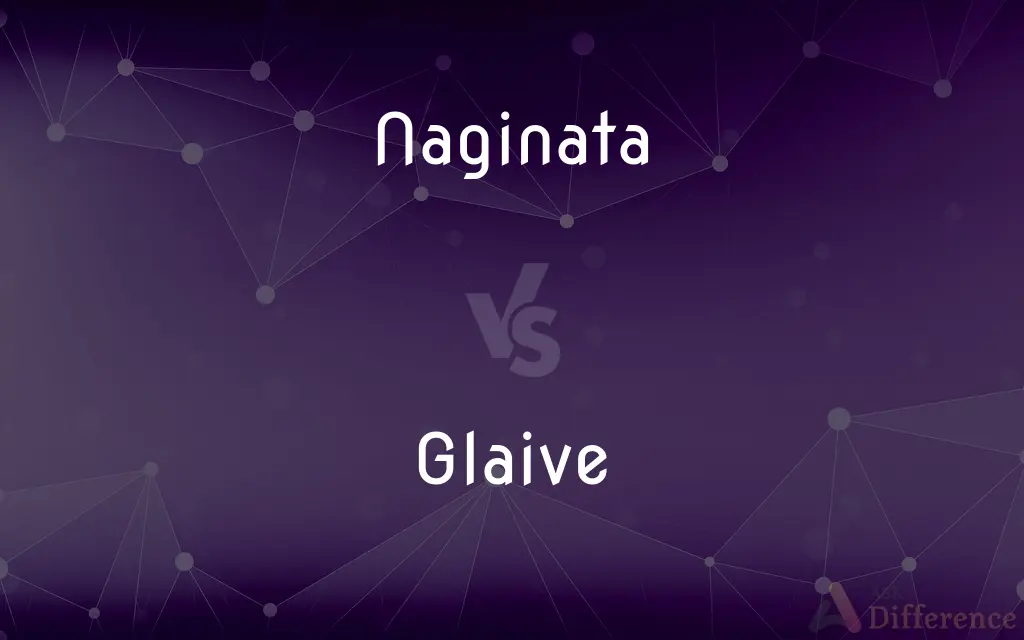Naginata vs. Glaive — What's the Difference?
Edited by Tayyaba Rehman — By Maham Liaqat — Updated on April 1, 2024
Naginata is a traditional Japanese pole weapon with a curved blade, while a glaive is a European polearm with a straight or slightly curved blade.

Difference Between Naginata and Glaive
Table of Contents
ADVERTISEMENT
Key Differences
The naginata is a pole weapon that was traditionally used in Japan, characterized by a long wooden shaft and a curved blade at one end. It is known for its versatility in both slicing and stabbing motions. On the other hand, the glaive is a European polearm that typically features a straight or slightly curved blade mounted on a long shaft, designed primarily for slashing.
Historically, the naginata was prominently used by the samurai class of feudal Japan, as well as by sohei (warrior monks) for its effectiveness in both mounted and foot combat. Whereas, the glaive found its place in the medieval European battlefield, wielded by infantry for its reach and ability to counter cavalry.
The design of the naginata allows for a wide range of combat techniques, including sweeping cuts, thrusts, and parries. The curved blade is effective for both cutting and hooking enemies. In contrast, the glaive's design is more suited for slashing attacks against foot soldiers, with the straight edge providing a powerful cutting force.
In terms of cultural significance, the naginata holds a special place in Japanese martial arts and is still practiced today in the form of naginatajutsu, which emphasizes grace, form, and technique. The glaive, while not as prominent in modern times, is celebrated in historical reenactments and medieval combat sports, showcasing its role in European warfare.
Both the naginata and the glaive reflect the military technologies and tactics of their respective cultures, with the naginata symbolizing the martial artistry of the samurai, and the glaive representing the brute force of medieval European warfare.
ADVERTISEMENT
Comparison Chart
Origin
Japan
Europe
Blade Shape
Curved
Straight or slightly curved
Primary Use
Slicing, stabbing, and hooking
Slashing
Historical Users
Samurai, warrior monks
Infantry
Modern Practice
Naginatajutsu (martial art)
Historical reenactment, medieval combat sports
Cultural Significance
Deeply integrated into Japanese martial arts and history.
Associated with medieval European warfare and knightly combat.
Compare with Definitions
Naginata
Curved, facilitating both cutting and hooking actions.
The naginata's curved blade makes it effective for wide sweeping motions.
Glaive
Utilized by European infantry to combat enemy forces, including cavalry.
The glaive was a common sight in medieval European battlefields, wielded by foot soldiers.
Naginata
A Japanese pole weapon with a curved blade used for slicing, stabbing, and hooking.
The warrior demonstrated the art of naginatajutsu, skillfully wielding the naginata.
Glaive
A European polearm with a straight or slightly curved blade, designed for slashing.
The medieval soldier was armed with a glaive, ready to face the cavalry charge.
Naginata
Includes a variety of techniques beyond slashing, such as thrusting and parrying.
The naginata practitioner executed precise thrusts and parries during the demonstration.
Glaive
Straight or slightly curved, optimized for powerful slashing attacks.
The glaive's blade, designed for slashing, inflicted severe wounds on the battlefield.
Naginata
Favored by samurai and warrior monks in feudal Japan.
In feudal Japan, the naginata was a symbol of the samurai's versatility on the battlefield.
Glaive
Primarily used for slashing, with limited thrusting capabilities.
With his glaive, the foot soldier delivered a series of lethal slashes against his opponents.
Naginata
Remains a significant part of Japanese martial arts.
Today, the naginata is celebrated in Japan through the practice of naginatajutsu.
Glaive
Celebrated in modern times through historical reenactments and combat sports.
Enthusiasts of medieval history often recreate battles using weapons like the glaive.
Naginata
The naginata (なぎなた, 薙刀) is a pole weapon and one of several varieties of traditionally made Japanese blades (nihonto). Naginata were originally used by the samurai class of feudal Japan, as well as by ashigaru (foot soldiers) and sōhei (warrior monks).
Glaive
A glaive (or glave) is a European polearm, consisting of a single-edged blade on the end of a pole. It is similar to the Japanese naginata, the Chinese guandao and pudao, the Korean woldo, the Russian sovnya, and the Siberian palma.
Naginata
A traditional Japanese halberd: a polearm historically used to cut down infantry and cavalry.
Glaive
A sword, especially a broadsword.
Glaive
A light lance with a long, sharp-pointed head.
Glaive
(historical) A weapon consisting of a pole with a large blade fixed on the end, the edge of which is on the outside curve.
Glaive
A sword, particularly a broadsword.
Glaive
A weapon formerly used, consisting of a large blade fixed on the end of a pole, whose edge was on the outside curve; also, a light lance with a long sharp-pointed head.
Glaive
A sword; - used poetically and loosely.
The glaive which he did wield.
Common Curiosities
What is a naginata?
A naginata is a traditional Japanese pole weapon with a curved blade, used for slicing, stabbing, and hooking.
What made glaives effective in medieval Europe?
Their long reach and powerful slashing capability made glaives effective against both foot soldiers and cavalry.
How were naginatas used historically?
Naginatas were used by the samurai and warrior monks of feudal Japan in various combat situations, including on horseback and on foot.
What is the difference between the blade of a naginata and a glaive?
The naginata features a curved blade suitable for both cutting and hooking, while the glaive's blade is straight or slightly curved for slashing.
Are there modern uses for the glaive?
While not used in combat, the glaive is celebrated in historical reenactments and medieval combat sports.
How is the cultural significance of the naginata and glaive different?
The naginata holds a significant place in Japanese culture and martial arts, whereas the glaive is associated with the history and warfare of medieval Europe.
What is a glaive?
A glaive is a European polearm with a straight or slightly curved blade, primarily designed for slashing.
Can you practice naginatajutsu today?
Yes, naginatajutsu is practiced as a martial art today, focusing on the traditional techniques and forms of the naginata.
Is naginatajutsu similar to kendo?
While both are Japanese martial arts involving swordsmanship, naginatajutsu specifically focuses on techniques related to the naginata.
Did the samurai use glaives?
No, the samurai used naginatas. Glaives were used by European infantry.
Can glaives be used for thrusting?
While primarily designed for slashing, some glaive variants can be used for limited thrusting actions.
How did the design of the glaive evolve?
The design of the glaive evolved to meet the needs of medieval warfare, focusing on reach and slashing power to counter various threats.
What role did glaives play in medieval battles?
Glaives were primarily used by foot soldiers to deliver powerful slashes and defend against cavalry charges.
Why is the naginata considered versatile?
Its curved blade and long reach make it suitable for a variety of combat techniques, including slicing, stabbing, and parrying.
Share Your Discovery

Previous Comparison
Shelly vs. Shelley
Next Comparison
Lexophile vs. LogophileAuthor Spotlight
Written by
Maham LiaqatEdited by
Tayyaba RehmanTayyaba Rehman is a distinguished writer, currently serving as a primary contributor to askdifference.com. As a researcher in semantics and etymology, Tayyaba's passion for the complexity of languages and their distinctions has found a perfect home on the platform. Tayyaba delves into the intricacies of language, distinguishing between commonly confused words and phrases, thereby providing clarity for readers worldwide.















































